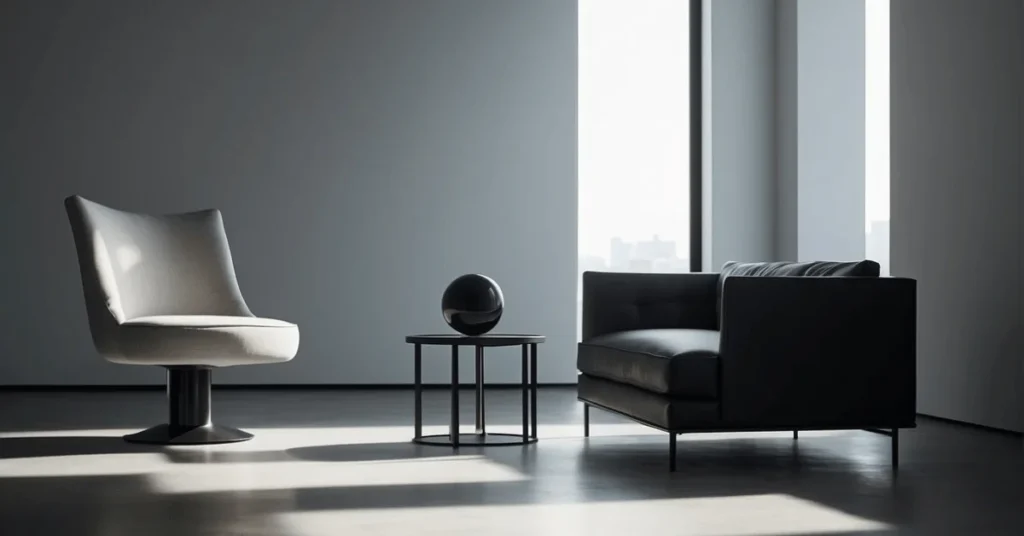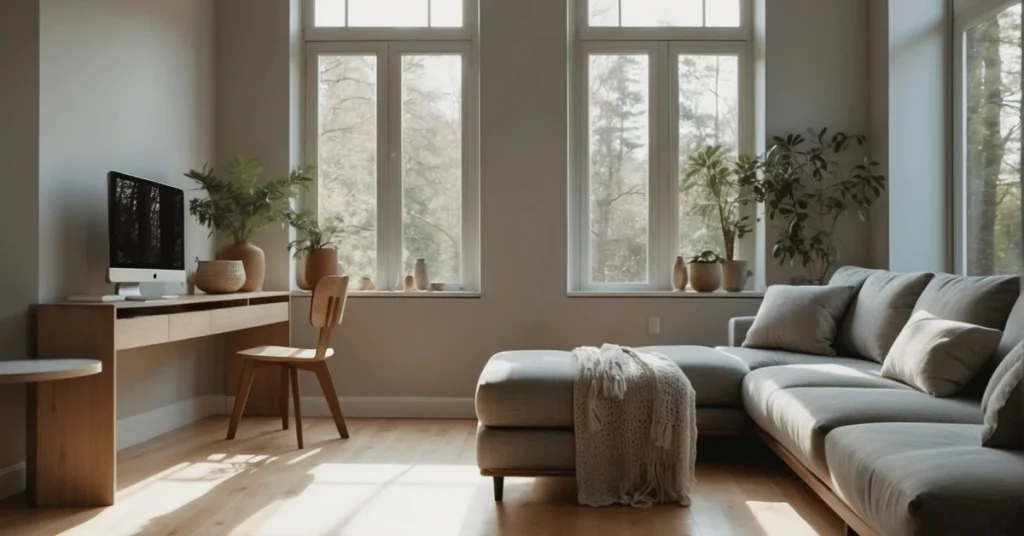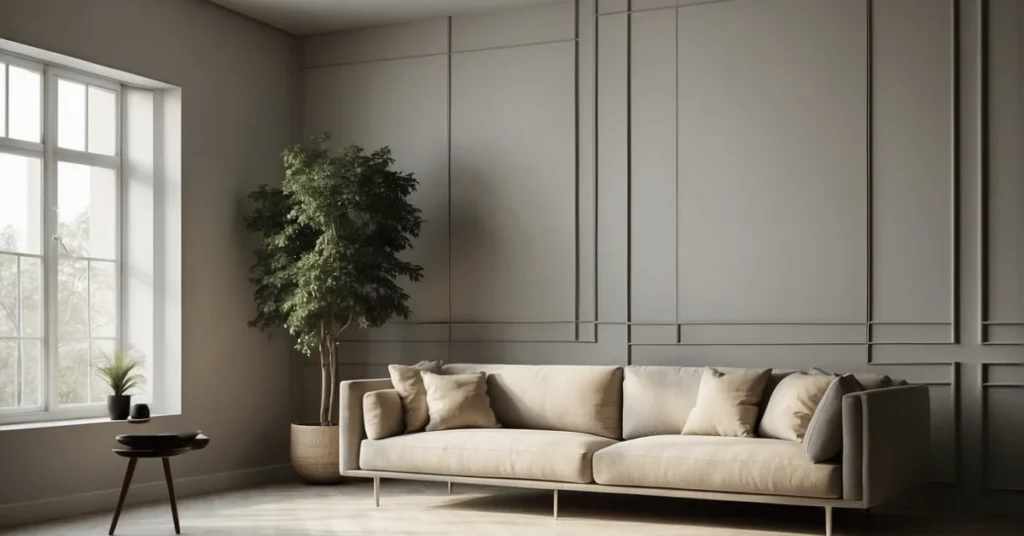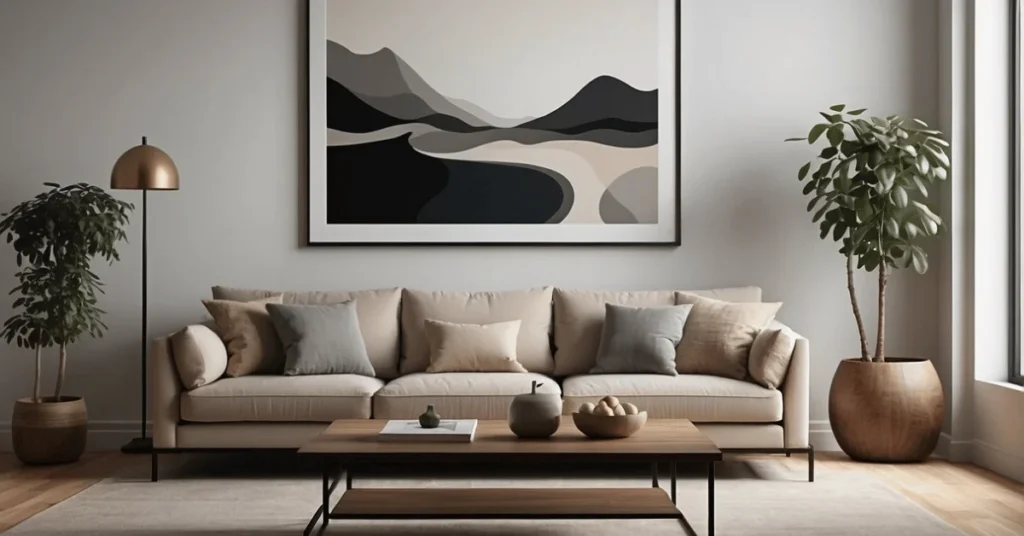Emerging from the minimalism of the mid-20th century, neo-minimalism art, also widely known as “Neo-Geo,” represents a fusion of simplicity and conceptual rigor.
As advocates of this movement, we see it not merely as a style but as an approach that strips artwork down to its essentials, probing the core of visual experience. The stark, often monochromatic compositions embody a philosophy of art that values the eloquent economy of form and materials.
Our exploration of neo-minimalism reveals its roots in the reaction against the excesses of its predecessor, Abstract Expressionism. Embracing a pared-down aesthetic, the movement offers a lens through which we can reassess the relationship between object, space, and viewer.
In both art and design, this minimalist approach has transformed and merged the boundaries of disciplines, influencing everything from architecture to lifestyle.
Key Takeaways
- Neo-minimalism emphasizes essential elements, fostering a deeper visual engagement.
- Historical shifts into minimalism paved the way for neo-minimalist approaches in art and design.
- This art form has significantly influenced various domains beyond traditional visual arts.
Historical Context
In surveying the evolution of abstract art, we recognize that neo-minimalism emerged as an eloquent expression of the late 20th and early 21st centuries, distilling complex concepts into simpler forms.
Origins of Neo-Minimalism
Neo-minimalism, often seen as a reaction against the expressive art movements preceding it, germinated from a desire to return to basic aesthetic principles. It signals a renewed interest in the minimalism of the 1960s and ’70s while simultaneously drawing from the wellspring of modernism and Bauhaus ideals. These earlier movements stressed the importance of form following function, a sentiment that neo-minimalism embraced and reinterpreted.
Influence of Modernism and Minimalist Art
The stark beauty of minimalist art shaped neo-minimalism profoundly. By embracing the modernist movement’s reductionist ethos, neo-minimalist artists sought to eliminate superfluous elements, thus allowing viewers to experience the essence of the artwork without distraction. Furthermore, the movement intersects with neo-conceptualism, often borrowing its intellectual rigor and engagement with postmodern discourse. This synthesis of ideas cultivated an artistic environment where simplicity could coexist with profound meaning, encapsulated by the conscientious use of space and material.
Key Principles of Neo Minimalism

When we explore Neo Minimalism, we find ourselves embracing the astounding power of simplicity and the famous ethos ‘less is more’. The elegance of this style lies in the intentional use of minimalist design elements to achieve a harmonious visual experience, centered around geometric abstraction and geometric forms.
Our Thoughts on Simplicity and ‘Less is More’
In our view, Neo Minimalism takes the essence of simplicity to heart. The notion that less is more is reflected not just in the aesthetic value but also in the way it manifests in various mediums—be it art, design, or architecture. By stripping away the superfluous, Neo Minimalism allows us to focus on the core substance without distraction.
- Harmony: Achieved through balanced compositions.
- Simplicity: A reduction to essential elements.
- Focus: Attention directed to the bare form and content.
Geometry in Design
Geometry plays a fundamental role in Neo Minimalist designs. By incorporating shapes like the square and rectangle, artists and designers convey messages in the simplest forms. These geometric forms bring a sense of order and clarity.
- Shapes: Square and rectangle dominate.
- Patterns: Repetition and alignment for visual rhythm.
The strategic use of geometric shapes results in designs that are not only aesthetically pleasing but also resonate with a calm and sophisticated character, true to the minimalist design philosophy of Neo Minimalism.
Top Notable Movements and Styles

In the realm of contemporary art, we observe a burgeoning spectrum of art movements that reshapes the way we perceive aesthetics and concepts. Among these, a few have resonated profoundly within the community, heralding new mediums and dialogues.
Neo-Futurism
Neo-Futurism, an offshoot inspired by early 20th-century futurism, embraces urban environments while forecasting the future of the human condition. With focus on technology and architecture, Neo-Futurism proposes daring structures and avant-garde designs, often encapsulated in the works associated with Neo-Futurism and the broader vision of neo-geo.
New Abstraction
New Abstraction entails a significant shift from traditional abstraction, which underscores minimalism and conceptual approaches. This movement paves the way for a rejuvenated form of art that transcends past notions to foster a language of simplicity and purity, aligning with movements like post-abstractionism. Artists associated with New Abstraction give rise to innovative expressions that redefine artistic boundaries.
Smart Art
Smart Art signifies a term denoting art that is cereberal and sophisticated, delving into the intellect rather than emotion. This term often overlaps with other movements such as neo-pop and poptometry, which rework pop art’s tenets for the digital age. Artworks within the realm of Smart Art skillfully integrate contemporary culture with critical commentary, thereby challenging viewers to engage with art at an intellectual level.
Influential Artists and Artworks

Neo-minimalism, often regarded as a pivotal chapter in contemporary art, has shaped the artistic landscape with its striking simplicity and conceptual depth. It’s a movement where the physicality of space meets the stark geometry of design, and where we encounter a refined distillation of form and content. Among the myriad of talented artists in this genre, certain names have risen as flag bearers of neo-minimalism through their sculptures, installations, paintings, and graphic designs.
Sculpture and Installation Art
- David Burdeny: Known for his serene and polished sculptures, Burdeny’s work encapsulates the serene essence of neo-minimalism.
- Richard Serra: His massive, imposing steel structures redefine the relationship between art, viewer, and environment.
- Lorenzo Belenguer: Belenguer’s installations interact with light and shadow, creating engaging spaces that challenge perception.
Paintings and Graphic Design
- Ashley Bickerton: Bold and satirical, Bickerton’s paintings critique contemporary consumer culture with a neo-minimalist touch.
- Peter Schuyff: Schuyff’s graphic design work illustrates the movement’s influence beyond the canvas, permeating the day-to-day visual landscape.
Our journey through neo-minimalism introduces us to artists like Eve Leader and Christopher Willard who, although not as widely recognized, have contributed unique textures and strokes to the movement. Tim Zuck‘s work, while interweaving the figurative with the minimal, retains an evocative simplicity. We recognize the significance of each artist’s endeavor in expanding the boundaries of painting, sculpture, and graphic design within neo-minimalism.
Impact on Other Domains

When we explore the rippling effects of neo-minimalism, we discover profound influences far beyond the canvas. From the precise lines that define contemporary architecture to the pared-down aesthetics reverberating through music and sonic art, the principles of minimalism art have been instrumental in sculpting a distinct expression across various domains. Let us delve into how this art movement has cast its serene shadow over both the tangibles of space and the intangibles of sound.
Architecture and Space Design
Architecture has embraced neo-minimalism, with figures like Juhani Pallasmaa advocating for sensory experience over visual overload. Spaces are crafted with a focus on convenience, serving function while stripping away the unnecessary. In homes, office buildings, and public spaces, the minimalist art philosophy manifests in clean lines and open environments that encourage calm and clarity.
- Influence on residential design: pared-back aesthetics, focus on functionality
- Commercial spaces: utilization of open-concept layouts for better workflow and interaction
Music and Sonic Art
In music and sonic art, neo-minimalism strips back to the essentials, allowing simple patterns to evolve into evocative experiences. Musicians and composers distill their sounds to the most impactful elements. This echoes in the textures and rhythms of minimalist compositions, emboldening listeners to find complexity within the subtle.
- Minimalist compositions: emphasis on repetition and variation
- Sound design: use of space and silence as compositional tools
Every keystroke in typography, every icon on websites, is influenced by the ethos of neo-minimalism, proving that less is not only more but also everywhere. Our digital terrain itself is reshaped through minimalistic design for enhanced user engagement and visual tranquility. Through these pared-down approaches, neo-minimalism propels us towards understanding the profound beauty and efficiency of simplicity.
Contemporary Practice and Trends

As we explore the neo-minimalist art movement, we see a significant blend of mid-to-late-20th century developments that emphasize less is more. This philosophy underpins the latest trends where memorable, impactful images thrive on brevity and design convenience, catering to modern-day attention spans.
Digital and Flat Design
The concept of flat design has been pivotal in shaping digital aesthetics. We observe that designers have embraced minimalism, utilizing bold, simple graphics that are quickly digestible, making flat design extremely trending in user interfaces and branding. Efficient and eye-catching, these designs are created with the intent to be instantly recognizable and easily navigable for users.
- Key Characteristics:
- Bold, simplified graphics
- Lack of three-dimensional effects
Consumer Culture and Market Trends
In our consumer-driven world, neo-minimalism art resonates deeply. Market trends lean towards the minimalist credo that an artwork can be both minimal and expressive — a sentiment that appears to be growing stronger. Companies and individuals alike seek designs that are convenient and memorable, aligning perfectly with reduced attention spans and a desire for clutter-free visuals.
- Market Observations:
- Increased demand for minimalist designs
- Higher engagement with clean, impactful visuals
Frequently Asked Questions

In delving into neo-minimalism, we often encounter a series of pivotal inquiries that shed light on its distinctness and evolution. Let us explore these questions to better grasp the essence of neo-minimalism in art.
How is neo minimalism art differentiated from classic minimalism in art?
Neo minimalism art distinguishes itself by integrating conceptual frameworks and digital technology with the classical minimalism ethos of simplicity and objectivity. It reflects a contemporary twist on the reductionist values of its predecessor.
What are the core principles of neo minimalism art in visual arts?
The core principles of neo minimalism art revolve around simplicity, use of modern materials, and a refined aesthetic that communicates ideas subtly—often emphasizing conceptual depth within minimal forms and structures.
In what ways has modern neo minimalism art evolved from earlier minimalistic movements?
Modern neo minimalism art has evolved to embrace a broader spectrum of mediums, engaging with digital art landscapes and interactive installations, thus far beyond the strict geometric abstractions seen in early minimalism.
What techniques are commonly associated with neo minimalism art creation?
Techniques such as digital fabrication, the repurposing of everyday objects, and the minimalist presentation of videography are commonly associated with the neo minimalism art creation process.
How does neo minimalism art in architecture relate to neo minimalism in visual art?
Neo minimalism art in architecture correlates with visual art by adhering to function and form in a manner that prioritizes space, light, and materiality to influence experience—a shared foundation with its artistic counterpart.
Can the influence of neo minimalism art be seen in graphic design, and if so, how?
Undoubtedly, graphic design has embraced neo-minimalism art through clean lines, bold color blocks, and the considered use of negative space to convey messages that punch through with clarity and impact.
Thank you for reading! We’ve explored the essence of neo minimalism art, but now we want to hear from you. Share your thoughts, insights, or favorite pieces in the comments below! Let’s keep the conversation going.


